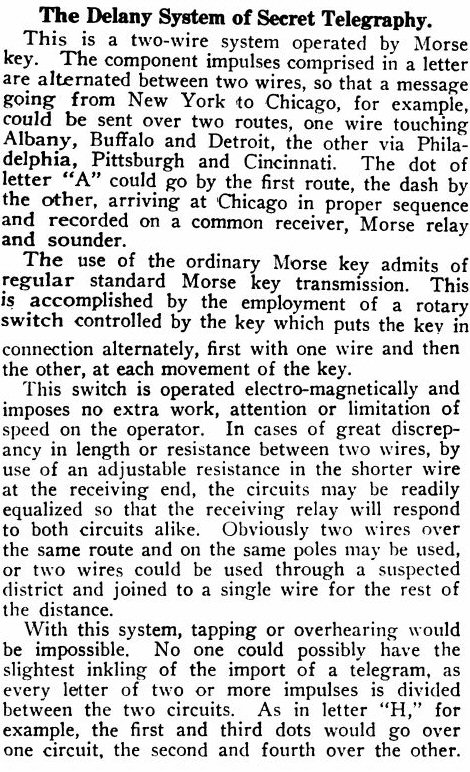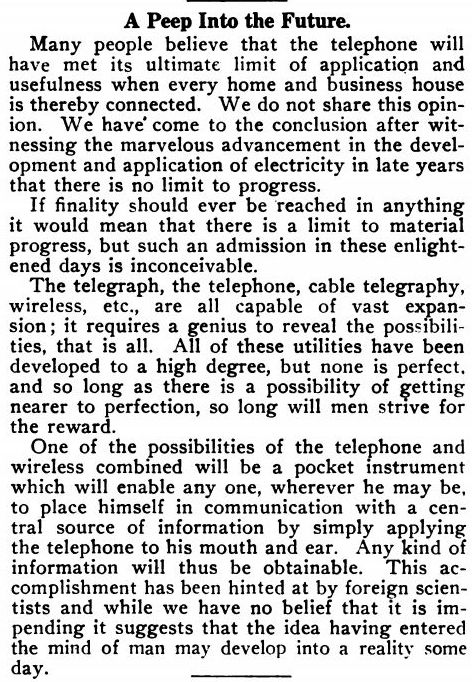Wednesday, May 08, 2019
Bad peep, good peep
In general, inventors and scientists 100 years ago had a vastly better understanding of Nature and human behavior than modern inventors. But not always....
 This Delany Secret Telegraph from a 1917 telegraph tech journal shows a complete lack of understanding in several stages.
First, acquiring two separate paths for your message was not easy. You'd need to pay for constant service at each transfer point, monopolizing the station so no other messages could ever pass through. Unless you owned the entire system, this peculiar pattern of payment would inform hackers that you were using a Delany setup. If you owned the entire system, you wouldn't need secrecy anyway because all the operators would be your employees.
Second, the alternation wouldn't hide anything. Sounders clicked down at the start of each dot or dash and up at the end. The sound wasn't a series of 'beeps', it was just clicks. Operators were accustomed to the overall rhythm. If you were hearing every other pulse, you were still hearing the same overall rhythm. It might be somewhat harder to perceive a non-language series of letters, but if you're sending a non-language series of letters you're simply using a cipher, which doesn't need any special technology.
A system that distributed pulses across a dozen different wires in a random order, presync'd between the sender and receiver, would be impossible for a hacker to perceive. But again, controlling a dozen different wires is only possible if you own the entire system.
= = = = =
Here's a much smarter item from the same 1917 journal:
This Delany Secret Telegraph from a 1917 telegraph tech journal shows a complete lack of understanding in several stages.
First, acquiring two separate paths for your message was not easy. You'd need to pay for constant service at each transfer point, monopolizing the station so no other messages could ever pass through. Unless you owned the entire system, this peculiar pattern of payment would inform hackers that you were using a Delany setup. If you owned the entire system, you wouldn't need secrecy anyway because all the operators would be your employees.
Second, the alternation wouldn't hide anything. Sounders clicked down at the start of each dot or dash and up at the end. The sound wasn't a series of 'beeps', it was just clicks. Operators were accustomed to the overall rhythm. If you were hearing every other pulse, you were still hearing the same overall rhythm. It might be somewhat harder to perceive a non-language series of letters, but if you're sending a non-language series of letters you're simply using a cipher, which doesn't need any special technology.
A system that distributed pulses across a dozen different wires in a random order, presync'd between the sender and receiver, would be impossible for a hacker to perceive. But again, controlling a dozen different wires is only possible if you own the entire system.
= = = = =
Here's a much smarter item from the same 1917 journal:

 This Delany Secret Telegraph from a 1917 telegraph tech journal shows a complete lack of understanding in several stages.
First, acquiring two separate paths for your message was not easy. You'd need to pay for constant service at each transfer point, monopolizing the station so no other messages could ever pass through. Unless you owned the entire system, this peculiar pattern of payment would inform hackers that you were using a Delany setup. If you owned the entire system, you wouldn't need secrecy anyway because all the operators would be your employees.
Second, the alternation wouldn't hide anything. Sounders clicked down at the start of each dot or dash and up at the end. The sound wasn't a series of 'beeps', it was just clicks. Operators were accustomed to the overall rhythm. If you were hearing every other pulse, you were still hearing the same overall rhythm. It might be somewhat harder to perceive a non-language series of letters, but if you're sending a non-language series of letters you're simply using a cipher, which doesn't need any special technology.
A system that distributed pulses across a dozen different wires in a random order, presync'd between the sender and receiver, would be impossible for a hacker to perceive. But again, controlling a dozen different wires is only possible if you own the entire system.
= = = = =
Here's a much smarter item from the same 1917 journal:
This Delany Secret Telegraph from a 1917 telegraph tech journal shows a complete lack of understanding in several stages.
First, acquiring two separate paths for your message was not easy. You'd need to pay for constant service at each transfer point, monopolizing the station so no other messages could ever pass through. Unless you owned the entire system, this peculiar pattern of payment would inform hackers that you were using a Delany setup. If you owned the entire system, you wouldn't need secrecy anyway because all the operators would be your employees.
Second, the alternation wouldn't hide anything. Sounders clicked down at the start of each dot or dash and up at the end. The sound wasn't a series of 'beeps', it was just clicks. Operators were accustomed to the overall rhythm. If you were hearing every other pulse, you were still hearing the same overall rhythm. It might be somewhat harder to perceive a non-language series of letters, but if you're sending a non-language series of letters you're simply using a cipher, which doesn't need any special technology.
A system that distributed pulses across a dozen different wires in a random order, presync'd between the sender and receiver, would be impossible for a hacker to perceive. But again, controlling a dozen different wires is only possible if you own the entire system.
= = = = =
Here's a much smarter item from the same 1917 journal:

